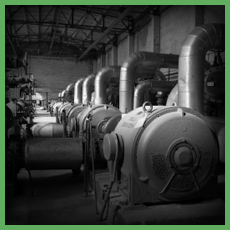OVERVIEW
Imagine you owned a business where half of your employees’ time was wasted or a restaurant where half of the food went unused. As illogical as it seems, this type of waste is commonplace when it comes to industrial “use” of energy. On average, 49% of the energy stored in coal and natural gas is lost as “waste heat” during the electricity generation and industrial heat processes.1 Through Combined Heat and Power (CHP), operators could capture and use waste energy from electric generators to heat or cool buildings or for industrial purposes. The most efficient CHP systems turn 80% of the energy in fuel into usable heat and electricity.2 Increasing electricity generation from CHP would allow businesses to do the same amount of work with less fuel, lowering costs and pollution at the same time.
ANALYSIS
Currently, CHP accounts for about 9% of all U.S. electricity generation capacity and could expand to 20%.3 Despite being environmentally4 and financially beneficial,5 CHP generation has actually declined in recent years.6 One of the most significant barriers to CHP deployment is onerous, inconsistent, and ill-defined standards for connecting to the electric grid.7 Additionally, as competition to traditional generation, it is often difficult for CHP operators to secure an interconnection to the grid, vital for selling excess power. Finally, CHP operators often have to sell excess electricity to utilities at rates that are below true market value while being forced to pay higher rates when they need to buy electricity.8
Despite President Obama’s executive order promoting CHP, more needs to be done to encourage its deployment.9 Standardizing interconnection policies and implementing more equitable pricing would make CHP a profitable option for a greater number of businesses to generate their own energy. Even modest gains can yield significant results: if CHP generation displaced an additional 3% of total U.S. generation, it would save 747 trillion BTUs (equivalent to 218,000GWh)10 per year.11 This would decrease CO2 emissions by 127 megatons, shaving off over 2% of U.S. energy-related carbon emissions.12 As many CHP component makers are based in the U.S., new investment would also translate into new domestic jobs,13 and lower fuel costs will free up money that firms could use for other investments.
IMPLEMENTATION
To overcome the barriers and economic disincentives for CHP. The federal government should take several actions.






